Intersubband transitions in InGaAs/AlInAs multiple quantum well systems¶
This tutorial calculates the eigenstates of a single, double and triple quantum wells. It compares the energy levels and wave functions of the single-band effective mass approximation with the 8-band \(\mathbf{k} \cdot \mathbf{p}\) model. Finally, the intersubband absorption spectrum is calculated.
Input files for both the nextnano++ and nextnano³ tools are available.
The following input files were used:
Single Quantum Well
1DSirtoriPRB1994_OneWell_sg_self-consistent_nn*.in(single-band effective mass approximation)1DSirtoriPRB1994_OneWell_kp_self-consistent_nn*.in(8-band \(\mathbf{k} \cdot \mathbf{p}\))1DSirtoriPRB1994_OneWell_sg_quantum-only_nn*.in(single-band effective mass approximation)1DSirtoriPRB1994_OneWell_kp_quantum-only_nn*.in(8-band \(\mathbf{k} \cdot \mathbf{p}\))
Two coupled Quantum Wells
1DSirtoriPRB1994_TwoCoupledWells_sg_self-consistent_nn*.in(single-band effective mass approximation)1DSirtoriPRB1994_TwoCoupledWells_kp_self-consistent_nn*.in(8-band \(\mathbf{k} \cdot \mathbf{p}\))1DSirtoriPRB1994_TwoCoupledWells_sg_quantum-only_nn*.in(single-band effective mass approximation)1DSirtoriPRB1994_TwoCoupledWells_kp_quantum-only_nn*.in(8-band \(\mathbf{k} \cdot \mathbf{p}\))
Three coupled Quantum Wells
1DSirtoriPRB1994_ThreeCoupledWells_sg_self-consistent_nn*.in(single-band effective mass approximation)1DSirtoriPRB1994_ThreeCoupledWells_kp_self-consistent_nn*.in(8-band \(\mathbf{k} \cdot \mathbf{p}\))1DSirtoriPRB1994_ThreeCoupledWells_sg_quantum-only_nn*.in(single-band effective mass approximation)1DSirtoriPRB1994_ThreeCoupledWells_kp_quantum-only_nn*.in(8-band \(\mathbf{k} \cdot \mathbf{p}\))
This tutorial aims to reproduce Figs. 4 and 5 of [SirtoriPRB1994].
This tutorial nicely demonstrates that for the ground state energy the single-band effective mass approximation is sufficient whereas for the higher lying states a nonparabolic model, like the 8-band \(\mathbf{k} \cdot \mathbf{p}\) approximation, is necessary. This is important for e.g. quantum cascade lasers where higher lying states have a dominant role.
Layer sequence¶
We investigate three structures:
a single quantum well
two coupled quantum wells
three coupled quantum wells
Material parameters¶
We use In0.53 Ga0.47 As as the quantum well material and Al0.48 In0.52 As as the barrier material. Both materials are lattice matched to the substrate material InP. Thus we assume that the InGaAs and AlInAs layers are unstrained with respect to the InP substrate. The publication [SirtoriPRB1994] lists the following material parameters:
conduction band offset |
Al0.48 In0.52 As / In0.53 Ga0.47 As |
0.510 eV |
conduction band effective mass |
Al0.48 In0.52 As |
0.072 m0 |
conduction band effective mass |
In0.53 Ga0.47 As |
0.043 m0 |
The temperature is set to 10 Kelvin.
Method¶
Single-band effective mass approximation
Because our structure is doped, we have to solve the single-band Schrödinger-Poisson equation self-consistently. The doping is such that the electron ground state is below the Fermi level and all other states are far away from the Fermi level, i.e. only the ground state is occupied and contributes to the charge density.
For nextnano++ we use:
# '0' solve Schrödinger equation only # '1' solve Schrödinger and Poisson equations self-consistently $SELF_CONSISTENT = 1 run{ !IF($SELF_CONSISTENT) poisson{ } quantum_poisson{ iterations = 50 } # Schrödinger-Poisson !ELSE quantum{ } # Schrödinger only !ENDIF } quantum { region{ ... Gamma{ # single-band num_ev = 3 # 3 eigenstates }
For nextnano³ we use:
# 'QUANTUM_ONLY': solve Schrödinger and Poisson equations self-consistently # 'SELF_CONSISTENT': solve Schrödinger equation only %QUANTUM_ONLY = .FALSE. %SELF_CONSISTENT = .TRUE. $simulation-flow-control !IF %QUANTUM_ONLY flow-scheme = 3 # Schrödinger only !IF %SELF_CONSISTENT flow-scheme = 2 # Schrödinger-Poisson !IF %QUANTUM_ONLY raw-potential-in = yes !IF %SELF_CONSISTENT raw-potential-in = no $quantum-model-electrons ... model-name = effective-mass # single-band number-of-eigenvalues-per-band = 3 # 3 eigenstates
Note
Single-band eigenstates are two-fold spin degenerate.
The Fermi level is always equal to 0 eV in our simulations and the band profile is shifted accordingly to meet this requirement.
8-band k.p approximation
Old version of this tutorial:
Becauce both, the single-band and the 8-band \(\mathbf{k} \cdot \mathbf{p}\) ground state energy and the corresponding wave functions are almost identical, we can read in the self-consistently calculated electrostatic potential of the single-band approximation and calculate for this potential the 8-band \(\mathbf{k} \cdot \mathbf{p}\) eigenstates and wave functions for \(k_\parallel = 0\).
For nextnano³ we use:
$simulation-flow-control !IF %QUANTUM_ONLY flow-scheme = 3 # Schrödinger only !IF %QUANTUM_ONLY raw-directory-in = raw_data/ !IF %QUANTUM_ONLY raw-potential-in = yes $quantum-model-electrons ... model-name = 8x8kp # 8-band k.p number-of-eigenvalues-per-band = 6 # 6 eigenstates
Note
One \(\mathbf{k} \cdot \mathbf{p}\) eigenstate for each spin component.
New version of this tutorial:
We provide input files for:
self-consistent single-band Schrödinger equation (because the structure is doped)
single-band Schrödinger equation (without self-consistency)
8-band \(\mathbf{k} \cdot \mathbf{p}\) single-band Schrödinger equation (without self-consistency)
For a), although the structure is doped, the band bending is very small. Thus we omit for the single-band / \(\mathbf{k} \cdot \mathbf{p}\) comparison in b) and c) the self-consistent cycle.
Results¶
Single quantum well
Figure 2.4.341 shows the lowest two electron eigenstates for an In0.53 Ga0.47 As / Al0.48 In0.52 As quantum well structure calculated with single-band effective mass approximation and with a nonparabolic 8-band \(\mathbf{k} \cdot \mathbf{p}\) model.
The energies (and square of the wave functions \(\psi^2\)) for the ground state are identical in both models but the second eigenstate differs substantially. Clearly the single-band model leads to an energy which is far too high for the upper state.
Our calculated value for the intersubband transition energy \(E_{12}\) of 255 meV compares well with both, the calculated value of [SirtoriPRB1994] (258 meV) and their measured value (compare with absorption spectrum in Fig. 4 of [SirtoriPRB1994]).
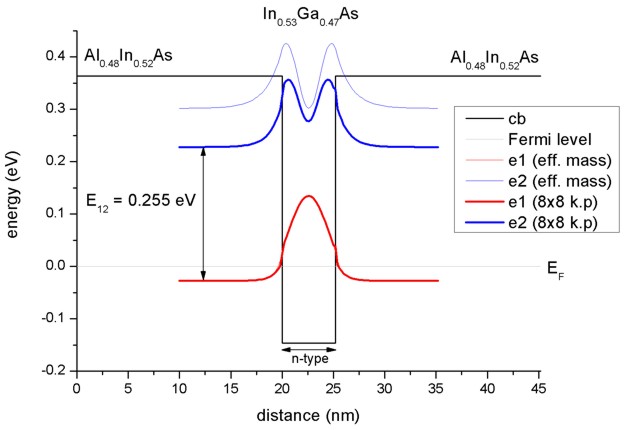
Figure 2.4.341 Conduction band edge, Fermi level and confined electron states of a quantum well¶
The calculated intersubband dipole moments are:
\(z_{12}\) = 1.55 nm (single-band)
For comparison: \(z_{12}\) = 1.53 nm (exp.), \(z_{12}\) = 1.48 nm (th.) ([SirtoriPRB1994])
The influence of doping on the eigenenergies is negligible (smaller than 1 meV).
Two coupled quantum wells
Figure 2.4.342 shows the lowest three electron eigenstates for an In0.53 Ga0.47 As / Al0.48 In0.52 As double quantum well structure calculated with single-band effective mass approximation and with a nonparabolic 8-band \(\mathbf{k} \cdot \mathbf{p}\) model.
The energies (and square of the wave functions \(\psi^2\)) for the ground state are very similar in both models but the second and especially the third eigenstate differ substantially. Clearly the single-band model leads to energies which are far too high for the higher lying states.
Our calculated values for the intersubband transition energies \(E_{12}\) = 150 meV and \(E_{13}\) = 267 meV compare well with both, the calculated values of [SirtoriPRB1994] (150 meV and 271 meV) and their measured values (compare with absorption spectrum in Fig. 5 (a) of [SirtoriPRB1994]).
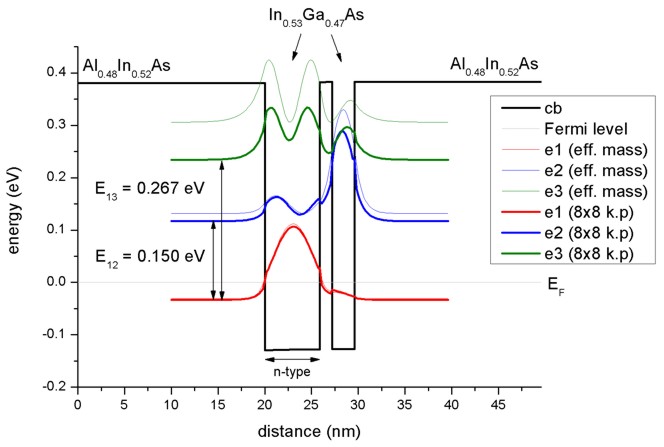
Figure 2.4.342 Conduction band edge, Fermi level and confined electron states of two coupled quantum wells¶
The calculated intersubband dipole moments are:
\(z_{12}\) = 1.61 nm (single-band)
\(z_{13}\) = 1.11 nm (single-band)
For comparison: \(z_{12}\) = 1.64 nm (exp.), \(z_{12}\) = 1.65 nm (th.) ([SirtoriPRB1994])
The influence of doping on the eigenenergies is almost negligible (between 0 and 2 meV).
Three coupled quantum wells
Figure 2.4.343 shows the lowest four electron eigenstates for an In0.53 Ga0.47 As / Al0.48 In0.52 As triple quantum well structure calculated with single-band effective mass approximation and with a nonparabolic 8-band \(\mathbf{k} \cdot \mathbf{p}\) model.
The energies (and square of the wave functions \(\psi^2\)) for the ground state are similar in both models but the second and especially the third and forth eigenstates differ substantially. Clearly the single-band model leads to energies which are far too high for the higher lying states.
Our calculated values for the intersubband transition energies \(E_{12}\) = 118 meV, \(E_{13}\) = 261 and \(E_{14}\) = 370 meV compare well with both, the calculated values of [SirtoriPRB1994] (116 meV, 257 meV and 368 meV) and their measured values (compare with absorption spectrum in Fig. 5 (b) of [SirtoriPRB1994]).
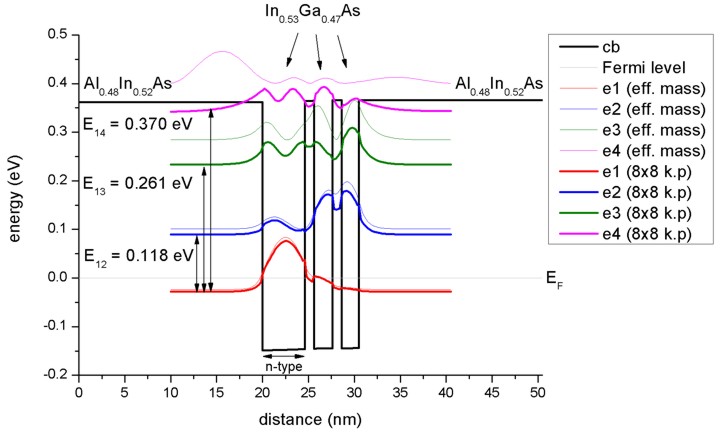
Figure 2.4.343 Conduction band edge, Fermi level and confined electron states of three coupled quantum wells¶
The calculated intersubband dipole moments are:
\(z_{12}\) = 1.81 nm (single-band)
\(z_{13}\) = 0.77 nm (single-band)
\(z_{14}\) = 0.30 nm (single-band)
For comparison: \(z_{12}\) = 1.86 nm (exp.), \(z_{12}\) = 1.84 nm (th.) [SirtoriPRB1994]
The influence of doping on the eigenenergies is almost negligible (between 0 and 4 meV).
— Begin —
Automatic documentation: Running simulations, generating figures and reStructured Text (*.rst) using nextnanopy
The following documentation and figures were generated automatically using nextnanopy.
The following Python script was used: intersubband_MQW_nextnano3.py
The following figures have been generated using nextnano³. Self-consistent Schrödinger-Poisson calculations have been performed for three different structures.
Single Quantum Well
Two coupled Quantum Wells
Three coupled Quantum Wells
The single-band effective mass and the 8-band \(\mathbf{k} \cdot \mathbf{p}\) results are compared to each other. In both cases the wave functions and the quantum density are calculated self-consistently. The \(\mathbf{k} \cdot \mathbf{p}\) quantum density has been calculated taking into account the solution at different \(k_\parallel\) vectors.
The absorption spectrum has been calculated using a simple model assuming a parabolic energy dispersion. The dipole moment \(z_{ij}=<i|z|j>\) has been evaluated only at \(k_\parallel =0\). The subband density is used to calculate the absorption spectrum. For the \(\mathbf{k} \cdot \mathbf{p}\) calculation, the density was calculated taking into account a nonparabolic energy dispersion, i.e. including all relevant \(k_\parallel\) vectors.
Quantum Well (single-band)
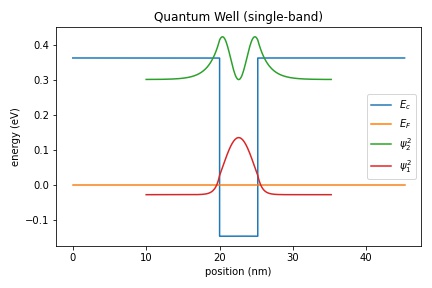
Figure 2.4.344 Conduction band edge, Fermi level and confined electron states of a quantum well¶
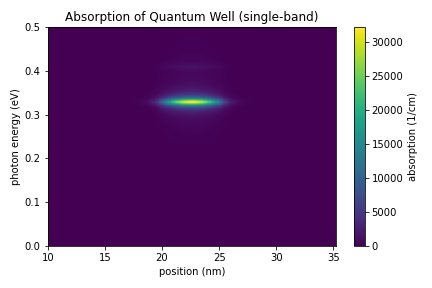
Figure 2.4.345 Calculated spatially resolved absorption spectrum \(\alpha(x,E)\) of a quantum well¶
Quantum Well (k.p)

Figure 2.4.346 Conduction band edge, Fermi level and confined electron states of a quantum well¶
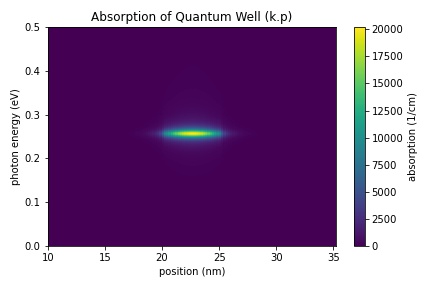
Figure 2.4.347 Calculated spatially resolved absorption spectrum \(\alpha(x,E)\) of a quantum well¶
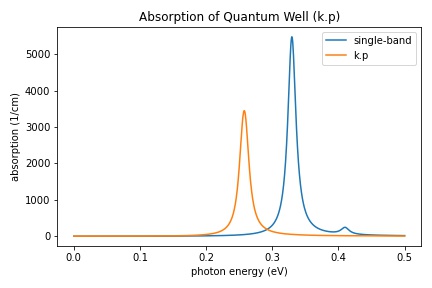
Figure 2.4.348 Calculated absorption spectra \(\alpha(E)\) of a quantum well¶
Two Coupled Quantum Wells (single-band)
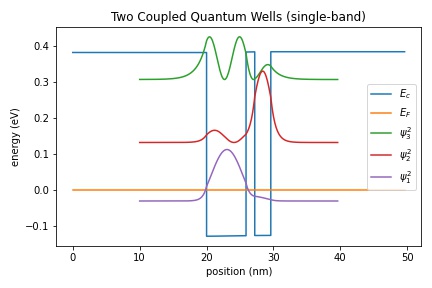
Figure 2.4.349 Conduction band edge, Fermi level and confined electron states of two coupled quantum wells¶
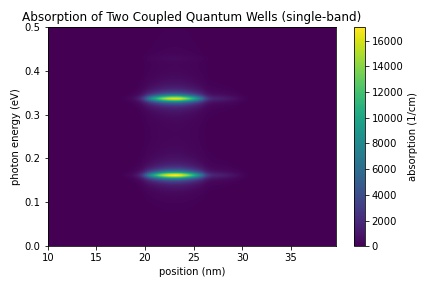
Figure 2.4.350 Calculated spatially resolved absorption spectrum:math:alpha(x,E) of two coupled quantum wells¶
Two Coupled Quantum Wells (k.p)
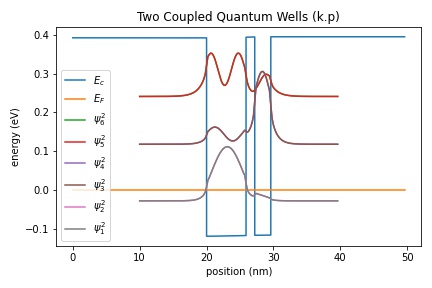
Figure 2.4.351 Conduction band edge, Fermi level and confined electron states of two coupled quantum wells¶
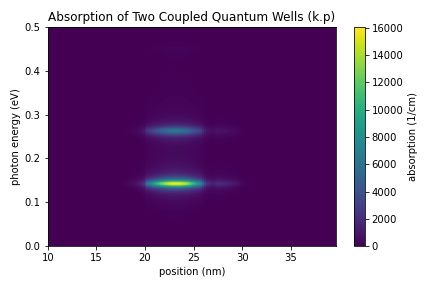
Figure 2.4.352 Calculated spatially resolved absorption spectrum:math:alpha(x,E) of two coupled quantum wells¶
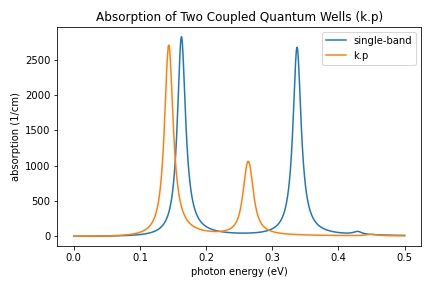
Figure 2.4.353 Calculated absorption spectra \(\alpha(E)\) of two coupled quantum wells¶
Three Coupled Quantum Wells (single-band)
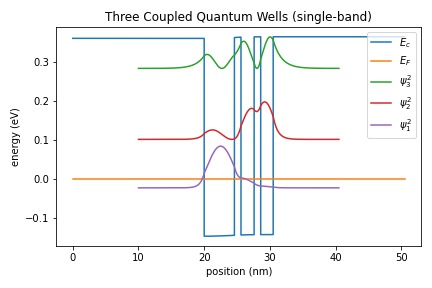
Figure 2.4.354 Conduction band edge, Fermi level and confined electron states of three coupled quantum wells¶
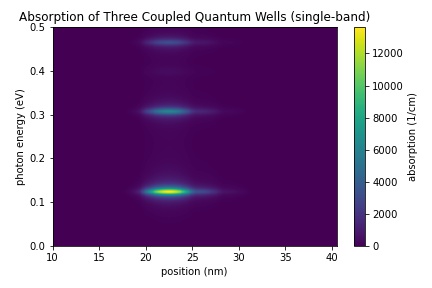
Figure 2.4.355 Calculated spatially resolved absorption spectrum \(\alpha(x,E)\) of three coupled quantum wells¶
Three Coupled Quantum Wells (k.p)
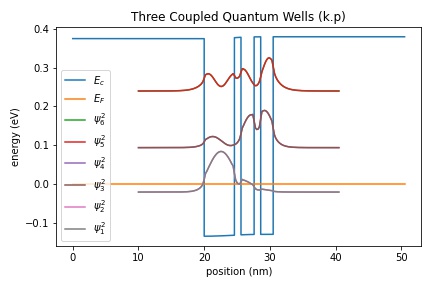
Figure 2.4.356 Conduction band edge, Fermi level and confined electron states of three coupled quantum wells¶
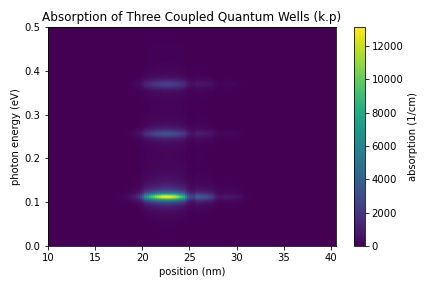
Figure 2.4.357 Calculated spatially resolved absorption spectrum \(\alpha(x,E)\) of three coupled quantum wells¶
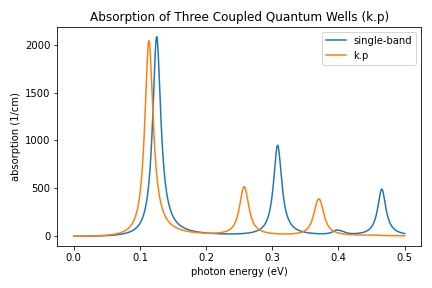
Figure 2.4.358 Calculated absorption spectra \(\alpha(E)\) of three coupled quantum wells¶
Automatic documentation: Running simulations, generating figures and reStructured Text (*.rst) using nextnanopy
— End —
Last update: nn/nn/nnnn